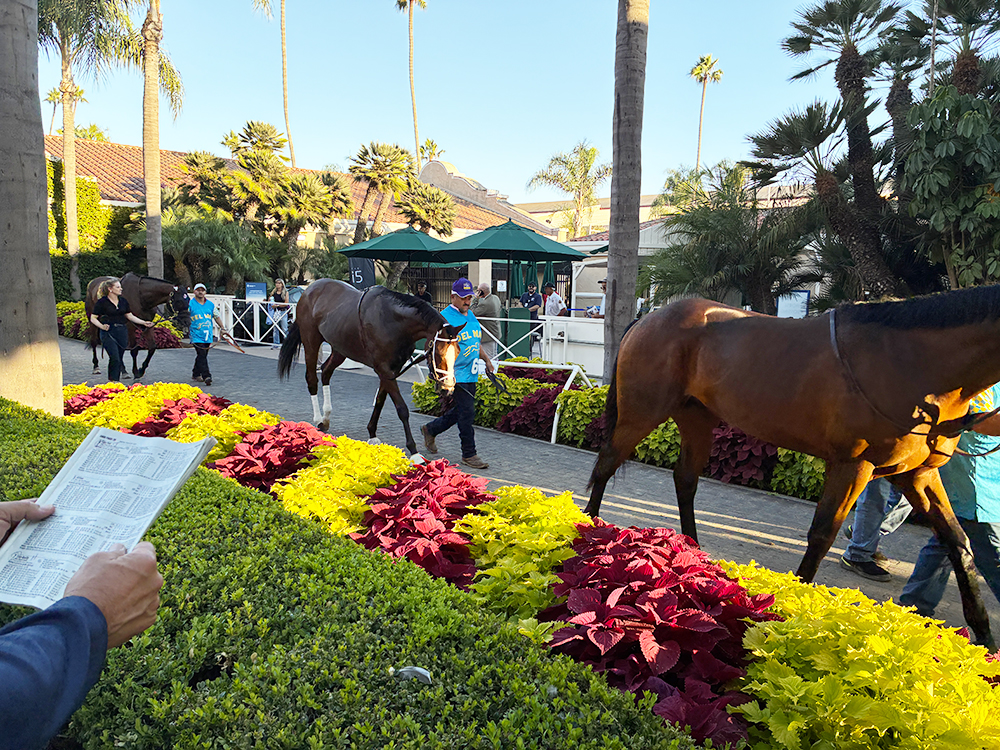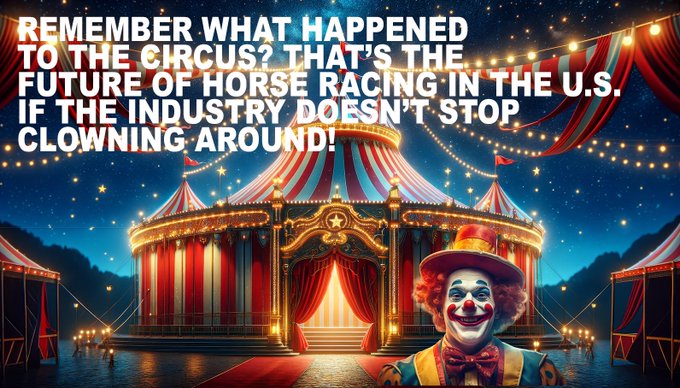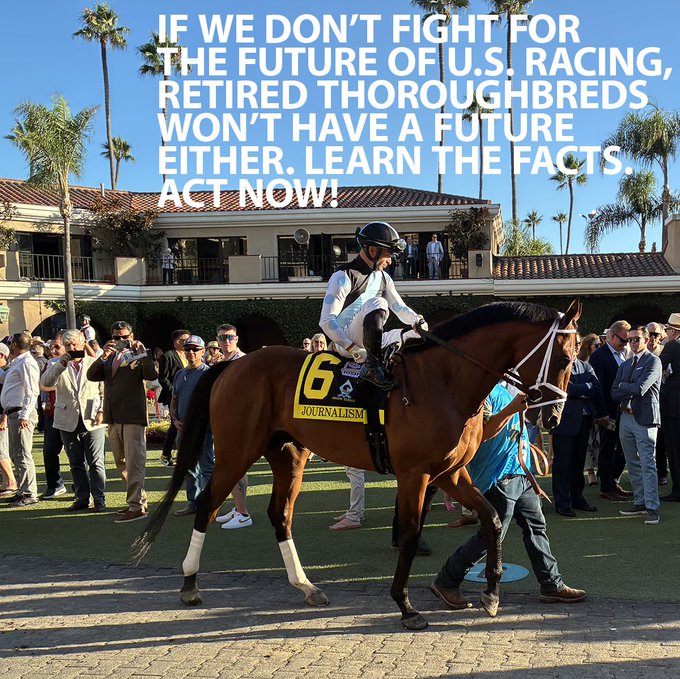


The declining popularity and financial challenges the U.S. horse racing industry faces today are the direct result of its failure to take responsibility for the lifetime care and welfare of every thoroughbred horse bred for racing. That situation must change if the industry is to survive.
The mission of Horsewatch Foundation is to educate the general public and lobby State and Federal legislatures regarding the urgent need for fundamental changes in the way the U.S. thoroughbred racing industry is funded, organized and operated. Horsewatch intends to help implement those changes by promoting voluntary cooperation and action where possible, the adoption of relevant State and Federal legislation as needed, and when necessary, the use of appropiate civil litigation in the State and Federal courts.
We invite like-minded individuals and organizations to join us in this effort and support Horsewatch's work, whether by volunteering to lend their expertise to our initiatives, working to organize meet-ups and town hall meetings across the country, lobbying State and Federal legislators and regulators - as well as providing financial support for the legal, administrative and public relations resources required to achieve its goals.


Ever wonder why horse racing is not as popular or financially successful as it was in the past? The biggest reason is that it has failed to offer a competitive entertainment and wagering product that's attractive to the general public. That wasn't always the case, in the early 1950's, horse racing was the Nation\'s leading spectator and wagering attraction. The trend since then has been entirely negative, with track attendance now falling well below any major national sport. Annual horse race wagering totals peaked in 2003, with a total inflation-adjusted handle of over $26 billion, compared to a 2024 total of $ 11.2 billion, a decline of approximately 57%. The average age of horse racing fans continues to rise, with proportionally fewer and fewer younger new fans and bettors entering the game.
With these facts in mind, what is the horse racing industry doing to materially improve its prospects, and counteract these negative trends? The short answer is almost nothing. The industry (and that includes State regulators and Horsemen's associations) has to take immediate steps to improve the financial health of the horse racing industry - both by attracting new participants, and taking giant steps forward to improve thoroughbred horse welfare. That means funding retirement benefits for all horses who need them, and refocusing the industry and the media on the true stars of the sport - the horses, full stop, period. Stop the life style stuff, the cocktails at the track, the fancy dresses, chit chat about controversial trainers, owners, and the like and pay attention to the horses. If the industry doesn't care about the horses, the general public won't care about horse racing and at the current rate, there won't be any more horse racing. Once horse racing is thriving again, everyone can dress up, drink and gossip until the cows come home. Until then, people have to get to work.
To provide one astounding example of how the industry is destroying itself, consider the state of horse race wagering in the U.S. Rather than exploring new methods to attract more bettors, and in particular a larger proportion of younger bettors, they are doing exactly the opposite. Computer Assisted Wagering (CAW) platforms like Curacao-based Elite Turf Club, which is owned and controlled by The Stronach Group together with NYRA who owns a 20% non voting interest (The Stronach Group also owns and operates Santa Anita and Gulfstream as well as the Advance Deposit Wagering (ADW) App Express Bet)-- and Velocity, a CAW that's owned and controlled by Churchill Downs (who also owns the Twin Spires ADW App). The Stronach/NYRA and Churchill Downs CAW platforms together control what some estimate as much as 40% of the total current betting handle in U.S. horse racing.
These computer-driven AI -like systems allow a wealthy elite to engage in high volume betting with privileged financial access to the parimutuel totes (because in Churchill Downs' case, they own and control United Tote, with a minority interest owned by NYRA and in the Stronach Group's case, they own and control AmTote International). Betting teams that execute complex computer-based wagers through Elite Turf Club and Velocity enjoy significant rebates on their betting unavailable to the average bettor (in effect, benefiting from radically lower take outs) as well as privileged access to the parimutuel pools themselves, through the totes, allowing CAW betting teams to move very large volumes of cash and bets into the pools within seconds, often moving the odds for their benefit at the expense of the ordinary bettor.
Rather than applying the technical advances made possible by computer-assisted wagering for the benefit of the betting public as a whole, by making betting simpler, more exciting and attractive to younger, less experienced betters by providing higher average returns to entice them into the sport, these entities are in effect shifting the benefit derived from those systems to a privileged elite at the direct expense of the average bettor. Apart from raising serious issues as to the legality of this process in so far as it appears to violate the fundamental basis of parimutuel betting, how is this calculated to expand interest in the sport? The fact that these systems are essentially controlled by the two of the largest owners of race tracks and tote systems in the U.S. creates the impression that the sport is being run by an oligopoly for its own benefit and that of an elite, and anonymous group of individuals at the direct expense of the financial future of the racing industry as a whole -- and hence to the financial detriment of the Thoroughbred horses that make racing possible in the first place.
Where are the controls on self-dealing, conflicts of interest, and adequate disclosure in this scenario? Do most bettors actually know that this is going on and are making the conscious decision to place retail bets, when they know that an industry-controlled oligopoly is instead focused on generating favorable returns for a privileged group of ultra high volume bettors at their expense?
Why aren't state horse racing regulators doing anything about this situation? I don't mean talking about it, or attending seminars, I mean implementing decisive regulatory action. Time, as always, is running short.

Much has been written recently about the plight of U.S. off-the-track thoroughbreds who have unfortunately wound up in the hands of unscrupulous entrepreneurs who hold them hostage for ransom in what are typically described as "kill pens" where most suffer from poor treatment and lack of medical care while waiting to be rescued by good Samaritans. However, the true scope and financial costs of the racing industry's thoroughbred retirement problem has largely been ignored. Providing professional life-long care for thoroughbred horses who are no longer racing is an expensive proposition that most people simply can't afford. It's worth remembering that thoroughbred horses are bred and registered with the Jockey Club for one purpose, and one purpose alone -- to participate in the business of horse racing, either in the United States or elsewhere in the world where the sport is still popular. They are born to run and are not necessarily bred or adapted for any other purpose. Beyond serving as companions or pasture props, there are other horse breeds that are intrinsically better suited to the avocation or profession of trail riding, dressage, eventing or show jumping. This is not to say, of course, that thoroughbred horses cannot have fulfilling careers in those disciplines, but to do so they require significant and not inexpensive training at properly equipped and financed facilities. Ignoring the reality and financial consequences of these facts, does no good for the welfare of 'rescued' horses or their future.
Here are some financial facts to consider. Current estimates of the monthly total cost for providing professional quality lifetime horse care to thoroughbred horses at professionally equipped, fully-amortized, facilities (where all explicit and implicit occupancy costs are taken into account) located in weather friendly, good horse infrastructure areas, including expenses for regular veterinary, dental and farrier services will currently range from $900- $1200 month. They will be higher over time, of course, as inflation takes its toll Based on these costs, the current total present value out-of-pocket cost of providing professional care to a foal crop of 14,000 thoroughbreds in the form of a retirement annuity purchased at foal registration could be as high as $1.6 billion dollars, assuming an actuarial interest rate of 5.5% and an average mortality age of 25 years. If you assume that forty percent of that 14,000 foal crop will be taken care of by the upper echelons of the horse racing community who have farms and/or financial resources to take care of those horses' retirement needs themselves on a 'self-insured', pay-as-you-go basis, that leaves a potential unfunded retirement cost liability for the remainder of the foal crop of as much as $1 billion. Closing the funding gap for that group of thoroughbreds would require the upfront payment of as much as $115,000 at time of foal registration or, say, five annual installments of as much as $37,000 per year for the first five years of the horse's life. The problem, in simple terms, is that possibly as many as 60% of all thoroughbred horses bred for racing are being bred by some owners who, to date, have not been financially able or willing to assume either individual or corporate liability for the lifetime retirement costs of those horses, a situation which is exacerbated by the fact that a thoroughbred's useful racing life is normally such a small fraction of their total life span. While many thoroughbred horses in that at-risk group are fortunate enough to find off-track homes through the kindness of strangers, their future is not assured, and remains mostly dependent on private buyers or charity.
Solving this funding gap requires two things to happen. The first is to recognize that breeders should be held primarily responsible for the lifetime costs of thoroughbred retirement, and the second is that the horse racing industry needs to focus on increasing the gross revenue and profit realized by breeders and owners from the horse racing business. That liability should then be managed and regulated to accommodate the sale of horses, either by private treaty or auction, to allow the transfer of that liability to financially-qualified purchasers during the ownership lifecycle. The continuing decline in popularity and finances of the American horse racing industry will not generate sufficient funds to solve the thoroughbred aftercare problem, given the way racing is organized and conducted today.. Participation and interest in horse racing has to increase by several orders of magnitude to generate the amount of money that would make the funding of thoroughbred retirement costs financially possible. Failing to accomplish both these goals will inexorably lead to the extinction of this much beloved and historically significant 'game' which once was and should again be a 'sport of kings' that the ordinary person can nonetheless enjoy.It's important to understand that U.S. horse racing can no longer survive without being aggressively managed, promoted and marketed by a single legal entity, the same as other major sports businesses in the U.S, such as the NFL, MLB, NBA, and NHL, The United States is the only major racing jurisdiction that lacks a national governing body, in contrast to Australia, England, France and Japan. Such a for-profit national U.S. governing organization would probably require the protection of specific or de facto exemptions from the application of the Antitrust laws as some other sports league organizations enjoy. Because of 10th Amendment restrictions on Federal jurisdiction over State police powers, the operation of such an entity would require each State in which horse racing is conducted to either cede their individual authority in favor of pattern State legislation, just as was done when the Uniform Commercial Code was adopted in the '50's and '60's. Such pattern legislation would have the effect of standardizing the operational and safety rules for horse racing and modernize the sport in order to increase revenue potential and interest among a wider demographic than exists at present. The alternative would be expand the applicaton of the HISA [Horse Racing Integrity and Safety Authority] Act to the overall Federal regulation of the industry, using the same Interstate Commerce Clause justification as currently underpins HISA.
These innovations should include the elimination of the present unfair arbitrage advantages afforded to computer assisted wagering syndicates, providing low cost and transparent access to all horse racing statistical data for the sport to facilitate the development of AI-based wagering and horse welfare tools that could distribute handicapping winnings across a broader spectrum of bettors, particularly younger, entry-level bettors, reducing the overlap and apparent time delays between scheduled race events, as well as the general adoption of fixed odds betting -- allowing all manner of exotic, post start and proposition wagers, as is the case with sports betting today -- all of which would be focused on attracting a younger, technologically more sophisticated audience, most of whom have been raised on computer games, To put that thought in perspective, total horse race wagering handle for 2024 was $11.27 billion, down for the third straight year, while video game spending stood at $58.7 billion, up from the prior year, with strong participation from the 18-34 demographic, at least 20 years younger than most who wager on horse racing today.
But just as important as implementing the changes described above, the industry also needs to re-focus on the welfare of the horse, full stop. It is the thoroughbred race horse itself which should be the focus of racing. An industry which fails to respect and honor the legacy of these noble beings does not deserve to survive. For all those who love and appreciate racing, the time to organize and take decisive action is now. Kicking the can down the road, tentative, cautious half-steps, cosmetic eye-wash, and sentimental hopes will not work. The industry and the people involved with it need to change, and they need to change now. The status quo is unacceptable.
If you care about the future of racing and the thoroughbred horses that depend upon it, are you willing to support a grass roots organization that will step up to this legal and financial challenge and make it happen? Please share your thoughts.
